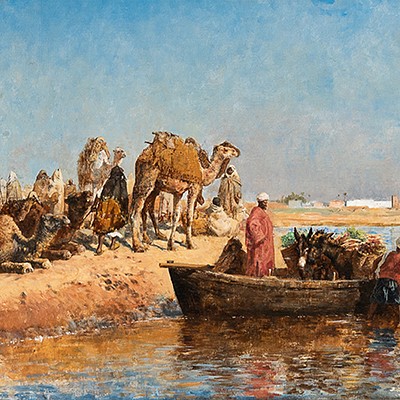Attributed to William Makepeace Thackeray (British, 1811-1863), The Bow/Man in Top Hat and Tails
Lot 229A
About Seller
Bonhams Skinner
274 Cedar Hill Street
Marlborough, MA 01752
United States
Founded over four decades ago, Bonhams Skinner offers more than 60 auctions annually. Bonhams Skinner auctions reach an international audience and showcase the unique, rare, and beautiful in dozens of categories, including the fine and decorative arts, jewelry, modern design, musical instruments, sc...Read more
Categories
Estimate:
$300 - $500
Absentee vs Live bid
Two ways to bid:
- Leave a max absentee bid and the platform will bid on your behalf up to your maximum bid during the live auction.
- Bid live during the auction and your bids will be submitted real-time to the auctioneer.
Bid Increments
| Price | Bid Increment |
|---|---|
| $0 | $10 |
| $100 | $25 |
| $500 | $50 |
| $1,000 | $100 |
| $3,000 | $250 |
| $5,000 | $500 |
| $10,000 | $1,000 |
| $30,000 | $2,500 |
| $50,000 | $5,000 |
| $100,000 | $10,000 |
| $300,000 | $25,000 |
| $500,000 | $50,000 |
| $1,000,000 | $100,000 |
About Auction
By Bonhams Skinner
Mar 17, 2022
Set Reminder
2022-03-17 10:00:00
2022-03-17 10:00:00
America/New_York
Bidsquare
Bidsquare : Fine Art: Now & Then
https://www.bidsquare.com/auctions/skinner/fine-art-now-then-9023
A live auction in two sessions. Session one begins at 10:00 am on March 17th and features Modern & Contemporary Art. Session 2 follows immediately after session 1 with European Art. Bonhams Skinner bidsquare@bonhamsskinner.com
A live auction in two sessions. Session one begins at 10:00 am on March 17th and features Modern & Contemporary Art. Session 2 follows immediately after session 1 with European Art. Bonhams Skinner bidsquare@bonhamsskinner.com
- Lot Description
Attributed to William Makepeace Thackeray (British, 1811-1863)
The Bow/Man in Top Hat and Tails
Inscribed "Early pencil/drawing by/Thackeray" l.l., with a faint notation beneath the figure's feet.
Pencil on laid paper, sheet size 6 7/8 x 3 1/4 in. (17.3 x 8.4 cm), framed.
Condition: Toning, scattered small pale spots, partially stabilized tear across u.r. corner, small tear at c.r. edge, affixed to back mat in several places around the perimeter of the reverse.
N.B. Most remembered as the author of Vanity Fair, Thackeray was a noted journalist, satirist, and also an able draughtsman and caricaturist. In an 1848 letter to William Smith Williams, Charlotte Brontë praised his abilities, writing "How can he render with a few black lines and dots, shades of expression so fine, so real; traits of character so minute, so subtle, so difficult to seize and fix - I cannot tell; I can only wonder and admire. Thackeray may not be a painter, but he is a wizard of a draughtsman; touched with his pencil, paper lives." (1)
Here Thackeray portrays what appears to be a man of African heritage in a pretentious pose with an exaggerated bow. Scholars have noted Thackeray's prejudice and racism which also extended to the Irish, foreigners, and Jews, and which has been described as extreme even by Victorian standards.
1. Sue Lonoff de Cuevas, 2011, "Thackeray's Drawings at Houghton Library," Harvard Library Bulletin 21 [4]:13-38. Quote sourced from The Letters of Charlotte Brontë, Margaret Smith ed., 3 vols. (Oxford: Clarendon Press, 1995-2004) 2:41 (Accessed on 2/10 https://dash.harvard.edu/handle/1/37363360)Condition
Any condition statement is given as a courtesy to a client, is only an opinion and should not be treated as a statement of fact. Skinner Inc. shall have no responsibility for any error or omission. The absence of a condition statement does not imply that the lot is in perfect condition or completely free from wear and tear, imperfections or the effects of aging. - Shipping Info
-
Please visit http://www.skinnerinc.com/services/payment-and-shipping/ for information regarding the collection of items purchased at auction.
-
- Buyer's Premium



 EUR
EUR CAD
CAD AUD
AUD GBP
GBP MXN
MXN HKD
HKD CNY
CNY MYR
MYR SEK
SEK SGD
SGD CHF
CHF THB
THB














